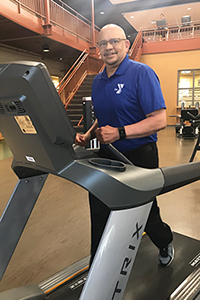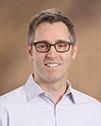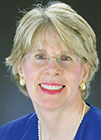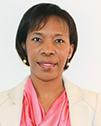By DALE SINGER
When Mike Meitzenheimer injured his foot, he wasn't able to get much exercise and started to put weight on quickly. A visit to the doctor led to an unpleasant surprise: He had joined the 86 million Americans whose higher than normal blood sugar loads constitute a condition called prediabetes.

Mike Meitzenheimer reversed his prediabetes condition with help from a diabetes prevention program at the YMCA of Middle Tennessee in Nashville.
That was three years ago. Meitzenheimer, who had moved to Nashville from Texas the year before, took charge of his health. He resumed an active lifestyle, working out at the YMCA of Middle Tennessee and joining a diabetes prevention program that gave him the tools he needed to reverse his prediabetes and reduce his risk of developing Type 2 diabetes — information he had not gotten from his doctor.
"The problem with physicians is that they don't have the time to really educate you about what's going on. They'll say treat this, watch your carbs, watch your sugars, get some exercise, and then you're on your way," Meitzenheimer said.
"The program taught me a lot about how to make good decisions, like how much I ate, how to read labels and determine portion sizes." The class met in 25, one-hour sessions over the course of a year. The curriculum emphasized healthy eating and increased physical activity. The small group bonded, reinforcing each other's efforts to make long-term lifestyle changes to stave off diabetes.
Meitzenheimer was so impressed with the program, he became a lifestyle coach and teaches a class at the downtown Nashville Y, helping others move toward a healthier lifestyle.
Meitzenheimer's arc from prediabetes diagnosis to education and lasting lifestyle change, achieved with support and encouragement from a local program, is a trajectory that Ascension is supporting in all its markets. In partnership with local institutions, Ascension is raising awareness of prediabetes and expanding access to diabetes prevention programs. Ascension facilities are providing resources, expertise and education to help stem the growing tide of diabetes in the United States.
Ted Cornelius, vice president of health innovation for the YMCA of Middle Tennessee, said Ascension has funded his Y's diabetes education class in the past and has identified participants for a class it wants him to start at an Ascension clinic serving low-income patients. He's looking for a Spanish-speaking facilitator to lead that class.

Cornelius
Outside the walls
The activity in Nashville fits well with Ascension's ongoing efforts to move upstream of disease, with community outreach initiatives that promote wellness and may help prevent the onset of avoidable chronic diseases such as Type 2 diabetes. Amy Freeman, president and chief executive of community health at Ascension, said the broad-based program to prevent diabetes and prevent or reverse prediabetes is a perfect example of the system's direction.
"We see this as a significant opportunity to improve health in the communities served by Ascension and to reduce the cost of care through prevention of a chronic health condition," Freeman said.
"Anytime you're doing community health work, you're really talking about key partnerships. At the national level, we're working with the YMCA, the CDC, the AMA — they all have a huge interest in terms of diabetes prevention and management," Freeman said. "At the local level, we've got ministries working with school systems to make sure healthy meals are provided in schools and with food banks to make sure there are healthy options there."

Freeman
Dr. Maria Mupanomunda, Ascension's director of community health, added that the system wants to empower people with the knowledge they need to take control of their health.
However, knowledge alone may not be enough to guarantee success. It's one thing for patients to know that exercise and weight loss can reverse prediabetes and allow better blood sugar control for patients with Type 2 diabetes, but they also have to be motivated to make sustained changes and have the resources to buy healthy foods. It helps to be part of a family or social network like those in the diabetes prevention classes that support patients in making the hard choices, she said.
Ascension has made a multiyear commitment to make diabetes prevention and management a priority in all its markets, and through that effort, to better understand how social and economic factors impact diabetes risk. That knowledge will assist in identifying other downstream efforts and interventions such as food security to further move the dial on prevention, Mupanomunda said.
Call to action
In fiscal year 2017, Ascension asked all its ministries to identify one health priority from their respective community health needs assessments and to demonstrate measurable progress toward the goal. The majority of Ascension markets identified diabetes or weight management as a significant unmet health need, and many proposed an action agenda promoting education, lifestyle changes and community support for developing healthier habits.

Mupanomunda
"We realized," Freeman said, "that over half of our ministries had identified diabetes as a community health priority, but we really didn't have a standardized approach or program or goals." And the markets were at different stages of maturity in community outreach on diabetes prevention and disease management.
Ascension then developed a systemwide approach that incorporates prevention, education and disease management, allowing for modifications that adapt to a community's demographics and challenges. It plans to identify successful programs and approaches within the ministry, then scale and replicate them throughout the system.
Freeman said that Ascension is accelerating this work by quickly disseminating best practices across the country so local ministries don't have to waste time identifying what works.
Mupanomunda said Ascension has asked all its ministries to sponsor community education programming to raise awareness of diabetes risk factors.
Ascension is requiring that all its markets offer evidence-based, clinically effective diabetes education programs, with a preference given to the CDC's National Diabetes Prevention Program, or another program acknowledged by the CDC as clinically effective. Each market must work to achieve a CDC status for programming called "recognition."
To achieve that status, local programs must meet metrics for participant retention and weight goals, among other criteria. "You submit your outcomes to the CDC, and they monitor your progress toward goal achievement," said Mupanomunda.
Ascension markets are at various stages of attaining CDC recognition. Some have mature diabetes prevention programs and others are just setting up community partnerships to raise diabetes awareness and offer education, she said.
Adapting to the community
The diabetes prevention initiative of Ascension's Providence Hospital in Mobile, Ala., extends to Bayou La Batre, Ala., a coastal hamlet with a population of 2,600.
Many residents are immigrants or refugees from Vietnam, Cambodia and Laos who were drawn to jobs in the area's seafood industry. According to the Asian Diabetes Prevention Initiative, Asians are at higher risk for developing Type 2 diabetes than people of European ancestry.
Kim Weems, Providence Hospital's advocacy and outreach manager, said that through an outreach program that offers screenings at churches, community centers and Asian temples in southern Mobile County, the hospital identified a number of individuals with diabetes and/or hypertension. It also collaborated with local clinics and Boat People SOS, an organization that aids Vietnamese refugees, to find others who would benefit from diabetic education or from assistance in obtaining medication and blood sugar testing supplies.
Providence found there was little diabetes education material available from the CDC or elsewhere in the native languages of the people in the high-risk Asian populations, and many of those patients lacked literacy skills in their own language.
Weems said persistence, understanding and the use of translators including monks from the local community is helping bridge the communications gap. The hospital wrote some of its own diabetes education materials and curriculum and it trained translators to stick to the text because some individuals had been adding their own opinions, she said. Providence also gives out grocery vouchers to reward low-income patients who comply with their care plans.
Results have been encouraging, Weems said, with more patients taking an active role in managing their health and keeping track of their progress.
"Less than 1 percent were testing (blood sugar levels) prior to working with us," she explained. "Now, 88 percent are testing.
"I think that we've helped a lot. We've seen a lot of changes in behavior, which is basically what diabetes education is, behavior modification."
Eye on community wellness
Mupanomunda said creating conditions that enable and support healthy choices in poor and vulnerable communities is the goal of the diabetes prevention initiative — one that won't be easy to achieve against the forces of poverty and the processed and fast food industry.
Dr. Kate Kirley, director of chronic disease prevention at the American Medical Association, is working with Ascension on the effort. And in the end, she said, the best result may be the most basic.
"We all want to improve the delivery of health care," she said, "but our ultimate goal is to improve health."
|
Toll of diabetes and prediabetes in the U.S.
Numbers from the Centers for Disease Control and Prevention give a good indication of the diabetes battle that Ascension and others are fighting.
The CDC's “National Diabetes Statistics Report” for 2017 provides this snapshot:
- 30.3 million Americans, or 9.4 percent of the nation's population, have diabetes.
- Of those, only 23.1 million have been officially diagnosed, so another 7.2 million have the disease but may not know it — nearly one-quarter of all those suffering from diabetes.
- An estimated 84.1 million Americans, or 33.9 percent of U.S. adults aged 18 years and up, had prediabetes in 2015. That includes nearly half of adults 65 years or older.
- The percentage of adults with diabetes grows with age, reaching a high of 25.2 percent among those aged 65 years and up.
- During 2011–2014, the age-adjusted prevalence of diagnosed and undiagnosed diabetes was higher among Asians, non-Hispanic blacks and Hispanics, compared to non-Hispanic whites.
- In 2015, 1.5 million new cases of diabetes were diagnosed among U.S. adults aged 18 years and up; more than half of these new cases were among adults aged 45 to 64 years.
- Of the 23.1 million Americans diagnosed with diabetes, 132,000 were children and adolescents younger than 18.
- Education level, which is an indicator of socioeconomic status, correlates with incidence of diabetes.
- In 2014, 7.2 million hospital discharges were reported among adults 18 or older who had diabetes as a listed diagnosis.
- Risk factors for complications for adults with diagnosed diabetes include smoking, being overweight and obese, being sedentary, and having high blood pressure, cholesterol or glucose levels.
|
Copyright © 2018 by the Catholic Health Association
of the United States
For reprint permission, contact Betty Crosby or call (314) 253-3490.